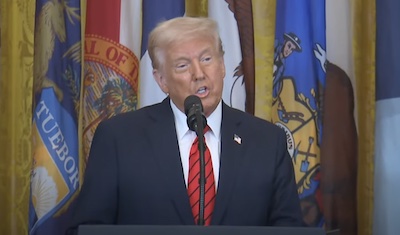So, we thought you might like a moment to take a beat and look at the financial events of the day from 30,000ft. After all the people getting hammered here probably aren’t us, but the gamblers at the Wall Street Casino.
“I’m not happy with what’s going on in the market today, but the distribution of equities across households…” “The top 10% of Americans own 88% of equities.” “The next 40% owns 12% of the stock market.” “The bottom 50% has debt. They have credit card bills, they rent their homes, they have auto loans.” “We’ve got to give them some relief.”
Treasury Secretary Scott Bessent
On April 2, 2025, President Donald Trump introduced a tariff policy, setting a 10% rate on all U.S. imports and higher reciprocal tariffs on certain nations. For China, this added a 34% tariff atop an existing 20%, totaling 54% on Chinese goods.
Dubbed “Liberation Day,” the move targeted trade imbalances. China countered on April 5 with a 34% tariff on all U.S. imports, effective next week, and restricted exports of rare earth minerals critical for tech and defense.
On April 7, Trump threatened an additional 50% tariff on Chinese goods—potentially hitting 104%—if China doesn’t rescind its 34% levy by April 8.
Global responses have been rapid. Over 50 countries have started trade talks with the U.S. since April 2. Taiwan cut tariffs on U.S. goods to zero, effective immediately, to bolster ties. Vietnam proposed zero tariffs on U.S. imports, and Cambodia reduced its rates to 5%. The UK, via Prime Minister Keir Starmer, signaled interest in enhanced trade discussions with the U.S., though specifics are pending. These shifts indicate nations are recalibrating amid U.S.-China tensions.
Markets have fluctuated. The S&P 500 saw its worst drop since June 2020 on April 3 following the tariff announcement but rebounded partially by April 7. Nike’s stock rose today, though exact gains weren’t specified. The elimination of the “de minimis” loophole—previously allowing duty-free imports under $800—has affected Chinese e-commerce players like Shein and Temu. Analysts project the tariffs could yield $1.9 trillion in revenue, possibly funding U.S. infrastructure, though this is unconfirmed.
China’s actions have spotlighted supply chains. Its April 5 rare earth export limits, targeting materials like dysprosium, have raised concerns in tech sectors. The U.S.-China tit-for-tat—34% tariffs from both, plus Trump’s 50% threat—has intensified the standoff, but a full trade war hasn’t materialized. India and Mexico are observing, with some sectors exploring non-Chinese supply options. China has pledged to “resolutely safeguard its interests,” per state media, without detailing further steps beyond current measures.
These tariff shifts could translate into new U.S. jobs. The higher costs of Chinese imports, potentially reaching 104%, may push companies to relocate manufacturing stateside. The “de minimis” closure could benefit domestic retailers, spurring hiring in logistics and sales. Firms like Nike, already seeing stock gains, might expand U.S. production facilities if tariffs persist, adding factory jobs. Analysts suggest the $1.9 trillion revenue could fund infrastructure projects—roads, bridges, ports—creating construction roles.
While reshoring faces challenges like higher labor costs, industries such as steel, textiles, and electronics, long outsourced to China, could see job growth if firms adapt. Employment data isn’t yet available, but the policy’s design incentivizes domestic investment, potentially reversing decades of offshoring as of April 7, 2025.
